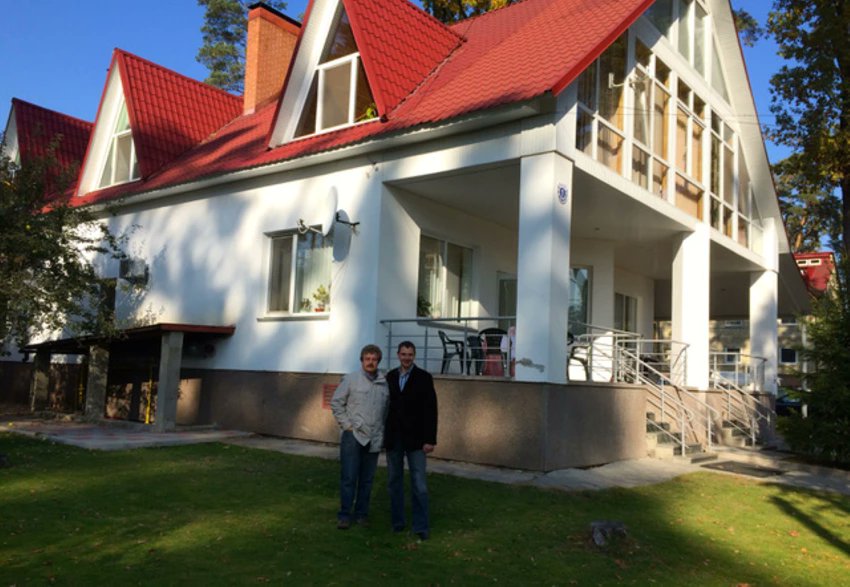1/ Vladimir Putin has reportedly built a luxury residence on an estate twice the size of Monaco, on the shore of Lake Ladoga just 31 km (19 miles) from the Finnish border. The @dossier_center has published some remarkable drone images of the complex. ⬇️ 

2/ The residence – one of several palatial Putin properties around Russia – is located on the shore of Maryalahti Bay, an inlet of Lake Ladoga about 185 km (115 miles) north of St Petersburg. The site has been carved out of the Ladoga Skerries National Park near Kortela.




3/ The complex comprises four groups of buildings known as the "Barn", the "Fisherman's Hut", the "Garden House" and the "Farm", plus a trout farm in the bay. The entire area (coordinates 61°32'12.3"N 30°25'52.7"E) covers about 4 km² (1.5 sq mi). 

4/ Although the names evoke rural idylls, the buildings are ultra-modern residences reportedly decorated with marble floors, semi-precious stones and luxury fittings including bidets costing $10,800 each and shower heads worth $4,600 each. There is even a private brewery.
5/ Leaked emails published in 2022 provided details of the buildings' interiors and construction works costing hundreds of millions of rubles. The Barn appears to be intended for entertaining guests, with a 200 m² open-plan dining area on the ground floor. 

6/ The Barn reportedly has a professional kitchen, a private brewery fitted out with €345,000 worth of Austrian brewing equipment capable of producing 47 litres of beer daily, and a second-floor tea room overlooking the lake. A helicopter landing pad is located to its rear. 

7/ After the start of the war in Ukraine, a curious flat mound was built behind the Barn. The Dossier Centre suggests that it may be intended for a short-range air defence system (SHORAD), probably something like a Pantsir S1, to defend against drone attacks. 

8/ At the time of the Dossier Center's flyby, no SHORAD was installed and anti-drone jamming was either off or ineffective. It's probable that they are only used when Putin is in residence. A photo in the video shows a SHORAD in position at some point in the winter. 

9/ A trout farm is located between the Barn and another building, the Fisherman's Hut. It's probably intended to provide guests with fresh fish. The site's guards reputedly sell fish from the farm to locals, likely as an unofficial supplement to their income.




10/ The Garden House appears to be intended for use as sleeping quarters, with luxurious sitting areas and six bedrooms inlaid with semi-precious stones such as lapis lazuli and labradorite. Another helicopter pad is located to the rear of this building.




11/ The Farm is reportedly used to raise bulls to provide guests with marbled beef. Since 2011, roads and power lines have been installed to serve the site, violating conservation rules in the surrounding national park. 

12/ The two main buildings also have landing jetties for large yachts. The entire site is heavily secured with fences, cameras and a permanent guard force who locals report are assiduous about keeping people out. 

13/ Putin's entourage has consistently denied that he has anything to do with the site. The buildings and the surrounding area belong to several companies controlled by Yuri Kovalchuk, a friend of Putin's and the main shareholder of Bank Rossiya, known as "Putin's bank". 

14/ Putin's association with the site nonetheless seems clear. Locals report that the FSO (federal protection service) secures it when he is in residence, and his luxury yacht 'Nega' is a periodic visitor. 

15/ It's not known how much the site cost, but given its size and ostentation, it's likely to be worth tens if not hundreds of millions of dollars. Meanwhile, the median monthly salary in Karelia is just $860 – a fifth of the cost of one of the Garden House's shower heads. /end 

Sources:
🔹
🔹
🔹
🔹
theguardian.com/world/2022/jun…
pikabu.ru/story/yuriy_ko…
occrp.org/ru/asset-track…
🔹
🔹
🔹
🔹
theguardian.com/world/2022/jun…
pikabu.ru/story/yuriy_ko…
occrp.org/ru/asset-track…
• • •
Missing some Tweet in this thread? You can try to
force a refresh












